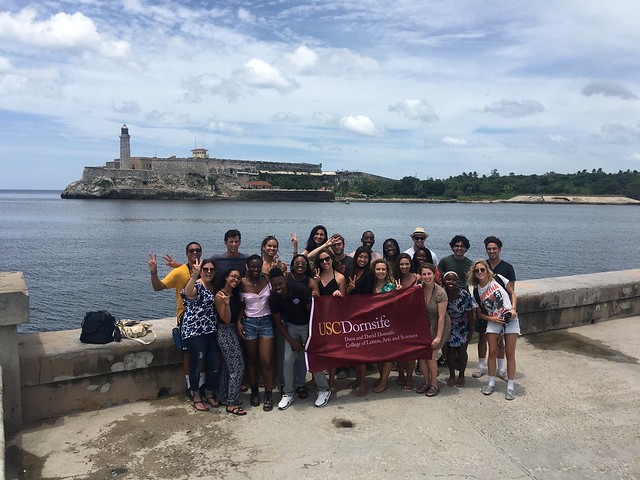Cuba Maymester helps USC students shatter stereotypes
“Amazing grace / how sweet the sound …” USC Dornsife junior Shernae Hughes’ clear voice filled the hushed lounge area of the senior day care center in Havana as she sang acapella to the audience of elderly Cubans who listened in delight. Earlier, the senior citizens had performed a traditional Cuban song for the group of visiting USC students and their professor. Now it was their turn to listen and enjoy the music.
Hughes, a political economy and African American studies major, was one of 21 USC undergraduates from diverse majors who traveled to Havana as participants in USC Dornsife’s Maymester course “Visualizing Cuba: Arts, Politics and Society in Today’s Cuba.”
Led by Ivette Gomez, assistant professor (teaching) of Spanish, the course provided two weeks of intensive preparation at USC Dornsife, followed by two weeks in Gomez’ native Cuba, allowing USC students to immerse themselves in the island nation’s vibrant culture while analyzing its visual arts, literature and music.
The students explored Old Havana, rode in vintage American cars along the Malecón, Havana’s fabled seafront promenade, and experienced the beauty of the country’s architecture. They also visited Ernest Hemingway’s house, discussed Cuba’s upcoming elections with a Cuban political science professor and met a female Afro-Cuban rap duo. Students were able to explore issues related to international relations between Cuba and the United States and to learn more about Cuba’s universal health care system and high literacy levels.
A dream trip
The Maymester, said Gomez — who grew up in Havana — was years in the making.
“It had long been a dream of mine to take students to Cuba,” she said. “President Obama’s trip to Havana last year, and the warming of Cuban-U.S. relations under his presidency, made me feel, more than ever, how important it was to seize this opportunity so that American students could go to Cuba and have a firsthand experience of the culture.”
Gomez also wanted Cubans to meet young American students. “Building those bridges was really important for me,” she said.
Gomez chose to teach the course in English to open it up to students from across the university.The undergraduates spent two weeks attending intensive classes at USC Dornsife to prepare for their trip. On May 29, they flew to Havana.
The students first visited the city’s historic core, where they learned about Cuba’s colonial history.
Autumn “Mai” Mizuno, a junior majoring in international relations, philosophy and law, described Cuba as “frozen in time for 60 years.”
“Havana is a very poetic place,” she said. “It’s this great symphony in terms of physical beauty and color, also in terms of how it sounds: the music, the people. It’s all very alive and the culture and history are hard to miss.”
The group traveled to Matanzas, dubbed “the Athens of Cuba” for its culture, Afro-Cuban folklore and French-influenced colonial architecture. There, they visited a women-led publishing house that produces art books from recycled materials and helped the staff make a book. They also donated acrylic paints they had brought from the U.S.
Students spoke to the moderator of the Presbyterian Church in Cuba about religion on the island and learned about Cuba’s history of slavery and plantations. They also met journalists, artists, doctors, faculty, writers and musicians.
During a Maymester trip to Cuba, USC Dornsife undergraduate Shernae Hughes sings for senior citizens
in Havana who respond with traditional Cuban songs. Footage courtesy of Mai Mizuno, editing by Mike Glier.
Not what they thought
Staying in casas particulares (private homes) with Cuban families enabled students to get to know their hosts and familiarize themselves with the Cuban way of life.
“They immediately experienced the friendliness and hospitality of the Cuban people,” Gomez said. “Many students told me, ‘This is not what I expected.’”
Indeed, the students were shocked to discover that the reality of Cuba is very different from how it’s often portrayed by politicians and media.
Economics major Nicholas Mockabee, who graduated in May, was struck not only by the lack of any visible military presence, as many students had expected, but also that Cubans embraced their American visitors with open arms.
“I had this preconceived notion that the Cuban people didn’t like Americans, that we just didn’t get along because of the whole Cold War situation, but it wasn’t like that at all,” he said.
Finding common ground
Indeed, Gomez said the students were surprised to find they had so much in common, especially with younger Cubans.
They formed a close bond with Ollie, their young scuba-diving Afro-Cuban guide, who spoke perfect English, learned from listening to rap music.
“The students noticed how well-informed and political he was,” Gomez said. “They asked, ‘Will you ever leave Cuba?’ And he replied, ‘No, this is the moment to be here.’”
